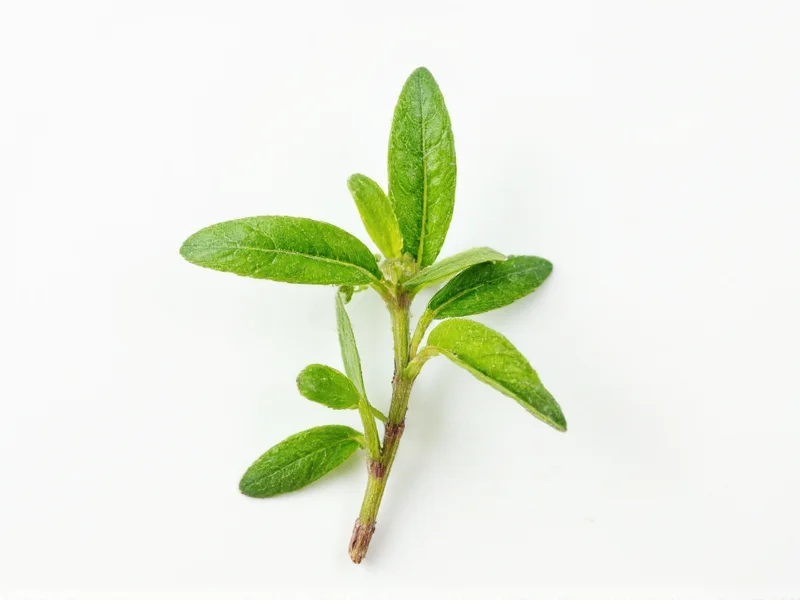Understanding herb measurements is essential for consistent cooking results, especially when working with fresh herbs like thyme. Many recipes call for "a sprig of thyme" without specifying exact quantities, which can lead to inconsistent flavor profiles in your dishes. Let's explore everything you need to know about measuring and using thyme sprigs effectively.
What Exactly Is a Sprig of Thyme?
A sprig of thyme refers to a small, individual stem cut from the thyme plant, complete with its tiny leaves. Unlike some herbs that have larger leaves, thyme grows in small clusters along thin, woody stems. When a recipe specifies "one sprig," it typically means a 1-2 inch segment of the herb with leaves intact.
Professional chefs and experienced home cooks recognize that the size of thyme sprigs can vary based on the plant's maturity and growing conditions. Younger plants produce more delicate sprigs, while mature thyme develops thicker, woodier stems with more concentrated flavor.
Thyme Measurement Conversions
Converting between fresh thyme sprigs and standardized measurements helps ensure recipe consistency. Here's a reliable conversion guide for sprig of thyme measurement in various cooking scenarios:
| Thyme Form | Equivalent Measurement | Best Usage Context |
|---|---|---|
| 1 fresh sprig (1-2") | ¼-½ tsp fresh leaves | Simmered dishes (stews, braises) |
| 3-4 fresh sprigs | 1 tsp fresh leaves | Roasts, marinades |
| 1 tsp fresh leaves | ⅓ tsp dried thyme | Quick-cooking dishes |
| 1 tbsp fresh leaves | 1 tsp dried thyme | Dry rubs, spice blends |
Substituting Dried Thyme for Fresh
When you need to make a fresh thyme to dried thyme conversion, remember that dried herbs are more concentrated. The general rule is to use one-third the amount of dried thyme compared to fresh. This is because the drying process removes moisture while concentrating the essential oils.
For example, if a recipe calls for 3 sprigs of fresh thyme (approximately 1 teaspoon of fresh leaves), you would use just ⅓ teaspoon of dried thyme. This thyme sprig equivalent adjustment prevents your dish from becoming overly medicinal or bitter.
Using Thyme Sprigs in Cooking
Chefs employ different techniques when incorporating thyme sprigs based on cooking method and desired flavor intensity:
- Whole sprigs in simmered dishes: Add 1-2 sprigs to soups, stews, or braises and remove before serving. The woody stem holds together during long cooking.
- Leaves only for finishing: Strip leaves from stems and sprinkle over finished dishes for brighter flavor.
- Infused oils: Steep 3-4 sprigs in warm olive oil for 30 minutes, then remove.
- Roasting: Tuck whole sprigs under poultry skin or alongside roasted vegetables.
When working with cooking with thyme sprigs, remember that the leaves contain most of the flavor while the woody stem primarily serves as a delivery mechanism for slow-cooked dishes. Never serve dishes with the woody stems intact, as they're unpleasant to eat.
Storing Fresh Thyme Properly
To maximize freshness and flavor of your thyme sprigs:
- Wrap stems in slightly damp paper towels
- Place in a loosely sealed plastic bag
- Store in the refrigerator's crisper drawer
- Use within 7-10 days for best flavor
For longer storage, freeze whole sprigs in olive oil using ice cube trays, or dry thyme by hanging bunches upside down in a dark, well-ventilated space. Proper storage maintains the herb's volatile oils that deliver thyme's characteristic flavor in your sprig of thyme recipes.
Common Thyme-Forward Recipes
Certain dishes particularly benefit from thyme's earthy, slightly floral notes. When following recipes that specify how much is a sprig of thyme, consider these classic applications:
- Coq au Vin: 3-4 sprigs simmered in the red wine sauce
- Roasted Chicken: 2 sprigs tucked under skin plus 3 in cavity
- Vegetable Stock: 5-6 sprigs for 4 quarts of stock
- Lemon-Thyme Vinaigrette: 1 tsp stripped leaves per cup of dressing
- Herb Roasted Potatoes: 2 tsp stripped leaves per pound of potatoes
Understanding these thyme measurement guidelines ensures your dishes achieve the perfect herb balance without overpowering other ingredients.
FAQ: Sprig of Thyme Questions Answered
How many teaspoons is one sprig of thyme?
One standard sprig of thyme (1-2 inches) yields approximately ¼ to ½ teaspoon of fresh thyme leaves when stripped from the stem. The exact amount varies slightly based on the thickness of the stem and leaf density.
Can I substitute dried thyme for fresh in recipes?
Yes, but use one-third the amount of dried thyme compared to fresh. For example, if a recipe calls for 1 teaspoon of fresh thyme leaves (about 3-4 sprigs), use just ⅓ teaspoon of dried thyme. Dried thyme has more concentrated flavor due to moisture removal during processing.
Should I remove thyme stems before cooking?
For long-cooking dishes like stews or braises, leave whole sprigs intact and remove before serving. For quick-cooking dishes or finishing touches, strip the leaves from the woody stems, as the stems become unpleasantly tough when eaten. Never serve dishes with the woody thyme stems included.
How do I measure thyme without a scale?
For small amounts, use measuring spoons: 3-4 sprigs typically fill 1 teaspoon when leaves are stripped. For larger quantities, estimate that a 4-inch sprig yields about 1 teaspoon of leaves. When precision matters, strip leaves from stems and measure in a dry measuring spoon, leveling off excess with a knife.
Why does my thyme taste bitter in recipes?
Bitter thyme usually results from using too much herb or adding it too late in the cooking process. Thyme's essential oils can become overpowering when used excessively. For balanced flavor, follow standard sprig measurements (1-2 sprigs per serving) and add early in cooking for long-simmered dishes to allow flavors to mellow and integrate properly.











 浙公网安备
33010002000092号
浙公网安备
33010002000092号 浙B2-20120091-4
浙B2-20120091-4